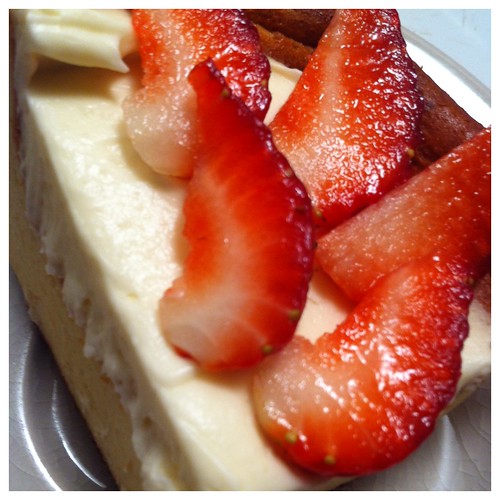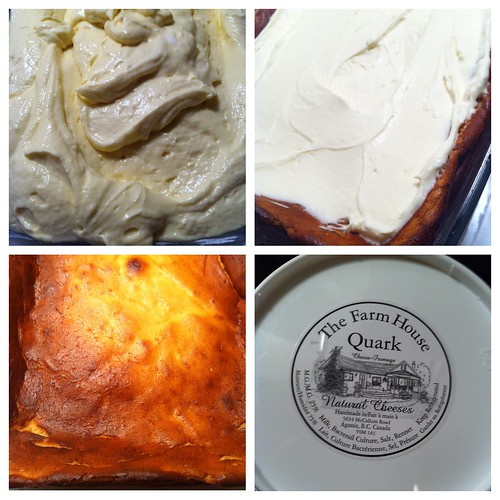Best Shavuot Cheescake Cake Ever

Shavuot, the holiday of receiving the Torah, and celebrating the wheat harvest, the first summer fruits and the newly born lambs and kids is here (the 2nd day of it, to be precise).
I've written before about milky notes in perfumery, and I have just updated it with some newly found and thought about notes.
For the culinary aspect of the holiday, eveyrone agrees that cheesecake is a must. Herding is the traditional, ancient lifestyle, and therefore celebrating the birth of newly born kids and lambs and the milk that flows with them is a tradition every late spring.
I'd like to share with you my favourite ever cheesecake. It is simple to make, but tastes and feels so extravagant, that I only bake it once a year - if I can. And if I can find quark cheese. Which should be more readily available for baking enthusiasts like me; but is not only hard to find but also ridiculously expensive. Even more than cream cheese. In Israel, the cheese used for that is a soft cheese simply titled "white cheese", and it's considered a staple food and priced accordingly. It also has far less butterfat - typically 9%, but also in lower fat (5% and 1%). Anyway, quark cheese is as close as it can get to the original recipe.

Ingredients:
1kg Quark Cheese
5 eggs, separated
1 package instant vanilla pudding (see notes below for alternatives)*
4 Tbs tapioca starch (or corn starch)
1.5 tsp Pure Vanilla Extract
1 cup fine raw sugar (evaporated cane juice)
Zest of 1 organic lemon
Pinch of salt
1 cup whipping cream
1/2 cup whole milk
For the cheesecake:
- Line a springform pan with parchment paper.
- Pre-heat the oven to 160c (320F)
- Beat the egg whites with a drop of lemon and a pinch of salt, just until light and fluffy.
- Add 1/2 cup of sugar and continue whipping until soft peaks form. Set aside
- Beat the yolks with the remaining sugar.
- Add 1tsp vanilla extract and the lemon zest
- Add the quark cheese and beat until smooth
- Beat in the tapioca starch and 4Tbs of instant vanilla pudding powder and ensure the mixture is smooth and uniform
- Fold the egg white mixture into the yolk until well blended.
- Pour into the pan and spread it evenly.
- Bake in the oven for 60-80min, until the cake is golden in the centre and lightly brown on the edges.
- Let the cake cool slowly inside the oven, while you leave the oven's door slightly open.
For the vanilla cream:
- Combine the whipping cream, milk, remaining package of instant vanilla pudding and 1/2tsp of pure vanilla extract in a bowl.
- Whip on high speed until the mixture is creamy and fluffy.
- Once the cake is completely cooled down, spread the cream on the cake and decorate as desired (you can make a pattern with a fork, or use a fancy piping if desired).
- Chill for at least 2 hours before serving.
- Serve alone or with fresh fruit. This cake is so incredibly balanced in flavour that I never feel I need to serve it with anything really; but chocolate milk is an option, as is cafe au lait, fruit flavoured kombucha or a milky oolong.
* This cake calls for instant vanilla pudding, which is essential for getting the beautifully smooth and thick cream on the top. This processed product has its merits, but also tastes like fake vanilla. To improve that, I suggest adding some pure vanilla extract to the cream. But you can also seek out alternatives to instant vanilla pudding cream if you're a purist.
If you'd like to substitute the instant vanilla pudding in the cheesecake portion (not the whipped cream topping) - I suggest you substitute the 4 Tbs of instant vanilla pudding mixture with 4 Tbs of tapioca starch, and add 1/8tsp xanthan gum. It works fantastically well consistency-wise (maybe even better than with the instant powder), and you won't feel at all as if the cake is any less sweet.
For the topping I'm still experimenting with more wholesome alternatives; but for now I just want the good old fashion flavour and texture of my grandma's cheesecake.



